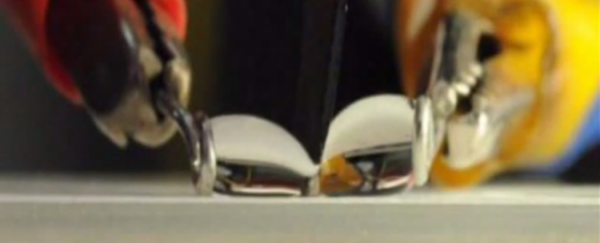
Filmed by a research group led by Ryan Yanashima from the Department of Chemistry & Biochemistry at Arizona State University in the US, this footage shows them attempting to bisect a simple water droplet sitting on a hydrophobic Teflon surface, using a superhydrophobic knife. And gosh, it's beautiful to watch.
The footage was captured as part of Yanashima and her colleagues' research into more efficient methods of cutting out and separating proteins from the biological fluids they're found in for analysis. The team made a number of special knives using polyethylene - a common plastic - zinc, and copper. Their surfaces were dipped into a solution of silver nitrate and a superhydrophobic solution called HDFT for 20 seconds, and once they were washed and air-dried, they were super-great at repelling water.
The team explained the purpose of their experiment in a 2012 edition of PLoS One:
"A particular focus is using the unique surfaces to enable the manipulation of individual drops, so that a complex mixture can be rapidly and inexpensively resolved into individual components. … Multi-protein separation is vital for the detection of important proteins that provide valuable information on gene expression, and can serve as early signals of a disease state."
What I want to know is, why isn't everything we own hydrophobic already? Why aren't our boots and umbrellas, laptop bags and coats hydrophobic? It's 2015, and I still can't wear suede in the rain? What we do have now is superhydrophobic metal, which is just as cool as it sounds.
Here's what it looks like when you cut a water droplet with a super-hydrophobic knife, but the two supporting wire hoops on either end are positioned too close together for the droplets to separate, so they bounce back together:

Source: Gizmodo
